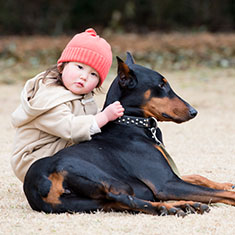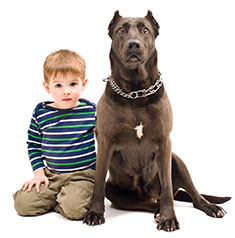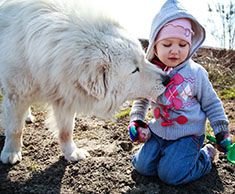Safely Introducing Your Dog to Children
So, you’ve socialized and trained your new dog, and you may be under the impression he or she is up for anything, but even the best-behaved animals may be challenged by young children. The last thing you want is to have your dog responsible for permanently disfiguring a child. Here’s our guide to keeping everyone safe when you introduce your dog to small children.

Start with Older Children
The younger the child, the less likely they will know how to treat a dog nicely. If you know ahead of time that you will be soon introducing your dog to toddlers, you might want to find a somewhat older child before the event to give your dog some practice.
Start with a Barrier
Always start a new experience with a fence or baby gate between your dog and the child. You never know what trauma your dog may have experienced with children before he or she came to live with you, so it’s best to be overly cautious at the beginning.
Bring your dog to his or her side of the fence, then ask the school-aged child to approach slowly and quietly from the opposite side. Watch carefully to gauge your dog’s response. Is he leaning forward in anticipation or backwards in fear? Is his tail high and wagging with excitement or between his legs? Has he raised the hair on the back of his neck or raised the sides of his muzzle to show his teeth? Both are signs of aggression.
If your dog appears to welcome the child’s presence, have the child put the palm of his or her hand flat against the fence or baby gage and allow the dog to sniff it. Again, watch your dog’s reaction.
Next, try an on-leash approach

If your dog has done well with the fence-line interaction, you are ready to try a closer introduction to the child with no barrier. However, you will still need to keep the dog under close control by using a short leash. Have the dog sit or lie down, then pull up most of the slack in the leash so the dog will be unable to lunge or jump on the child. Ask the child to enter your home or yard, again being calm and quiet.
Ask the child to present his or her hand to your dog, palm down with the fingers curled in so the dog cannot easily tear them off. Once the dog has sniffed the child’s hand, and if the dog appears to want the interaction to continue, the child should scratch the dog’s neck area, then slowly work either up and around to the top of the head or down toward the belly.
Some dogs are head shy and do not appreciate anyone reaching toward the top of their head. Always start with the chin and work your way to the top of the head or down to scratch the tender and vulnerable belly.
Keep all four feet on the ground

If all previous interactions have gone well, your dog is now ready to have unobstructed, unrestrained access to the older child. Walk your dog a short distance away from the child, then remove the leash, and ask the child to call the dog.
Stay close by and encourage your dog to keep all four feet on the floor while the child pets him or her. A big dog, especially, can cause real damage by knocking over a child. Ask the child to play with your dog with a favorite toy or to give the dog a treat.
Make sure the child offers the treat flat on his or her palm, not holding it between fingers and thumb. Your dog most likely cannot see past his nose to distinguish between the treat and the child’s fingers.
Train the child
Assuming your dog has done well with the older child, you’re now ready to introduce the dog to toddlers. However, you may need to spend some time educating young children on proper behavior around dogs. Of course, you will educate them about not pulling hair, ears, or tails, but it goes beyond that.
Children need to know to keep their hands and faces away from the dog’s mouth. They also need to understand that squealing, running children look very much like dinner to a dog who has a high prey drive. Teach young children to sit quietly and let the dog approach them until you see how things go.
Lastly, depending on the size and age of your dog, you may need the child to take special care to avoid hurting your dog. Very young dogs can easily be injured by well-meaning, but rambunctious children. Very old dogs may just not be interested in being bothered. Out of an abundance of safety, never leave your dog alone with a child, particularly if the dog and the child are strangers to each other.
Better safe than sorry
If at any point during your dog’s interaction with children of any age, the animal becomes upset or frightened, it may be prudent to decide you have an adults-only dog. Put the dog in a bedroom or leave him at home when you go visiting if children will be around. You will feel a million times worse if your dog bites a child than your dog can ever make you feel with his sad, brown “please don’t leave me behind” eyes.
Find the Best Dog Breeds for Children here.
Doggies Den: Latest Articles
 Homemade Thanksgiving Treats for Your Dog
Homemade Thanksgiving Treats for Your Dog
NUTRITION We all want to include our dogs in our holiday celebrations, but hopefully, you're aware that sharing table scraps with your dog isn't always the best idea.
 Keeping Your Dog Safe during the Summer Months
Keeping Your Dog Safe during the Summer Months
HEALTH Summer is coming on fast, so it’s time to plan how you will keep your dog safe and healthy through the lazy, carefree, warm days.
 Vaccination Time Again-Keeping Your Puppy Healthy
Vaccination Time Again-Keeping Your Puppy Healthy
DOG HEALTH So you have your new puppy picked out. There are quite a few shots, treatments and examinations that will keep the newest member of your family healthy.
 Canine Thanksgiving Feast
Canine Thanksgiving Feast
NUTRITION With the wide variety of food at Thanksgiving dinner, chances are you'll want to give your dog something special, too. If you're contemplating what to feed your dog for the holiday, here is a guide to a great Canine Thanksgiving Feast.
 Dog Walking Tips Every Owner Should Know
Dog Walking Tips Every Owner Should Know
DOG FUN Walking your dog is not only crucial to keeping him healthy and happy, it strengthens the bond between your canine friend and his caregiver. There are a lot of obstacles out there. Don’t forget these simple tips to keep your walk fun and safe in the outside world.
 The Benefits of Physiotherapy for your Dog
The Benefits of Physiotherapy for your Dog
HEALTH The same techniques that physiotherapists use to treat a variety of injuries and conditions in humans have been adapted to suit animals with great success. Family pets, show dogs, and working dogs can all benefit greatly from physiotherapy. Dogs whose activities involve a lot of agility are especially susceptible to the types of problems that physiotherapy can address.
 The Decision- Adding a Dog to Your Family
The Decision- Adding a Dog to Your Family
FIRST TIME OWNERSBringing a dog into your family is a decision where many people don’t realize it’s magnitude until after they have the dog. There are a number of things that you need to research before you decide to purchase a dog, and it starts right in your own home.
 Bringing Your Dog Into Your New Baby's Life
Bringing Your Dog Into Your New Baby's Life
HEALTH Many believe that a dog and a new baby cannot happily coexist, so therefore the dog has to go. This is not necessarily the case.  A new baby does not mean you have to abandon your dog.

Doggies Den:
Most Popular Articles

Dog Pregnancy Symptoms
HEALTHIf you suspect your dog might be pregnant, check out part one in this series on pregnant dogs, where we cover pregnant dog symptoms.

Dog Birth
HEALTHIn the third article of our dog pregnancy series, we look at the wonderful, but messy, process of bringing newborn puppies into the world.

Indoor Dog Potties
DOG PRODUCTSIt's been a long day at work. You were so busy, you didn't even take time to eat a sandwich, let alone run home to let your dog out. You're on your way home, knowing the poor dog is crossing his or her legs by now, when your car breaks down, delaying you even further. Can't somebody make this easier?

Your Dog’s Digestive System
PHYSIOLOGYEver wonder why your dog eats so fast? Or why he eats gross things? Or why he gets sick to his stomach? Or why his waste stinks so bad? Some of these things are normal, some are not.

Canine Respiratory System
BREATHINGThe basic function of your dog's respiratory system is to bring oxygen in to and remove carbon dioxide from the body. Knowing the symptoms of respiratory diseases can help you help your stay healthy.

Shelter Dog Adoption Tips for Success
ADOPTION Are you intimidated by the prospect of "rescuing" a dog from a shelter? One reason that you may be wary of adopting a dog from a shelter is not knowing how to choose. Adopting a dog from a shelter can be a rewarding process, if you're prepared to do a reasonable amount of research.

Canine Urinary Tract Infections
SYMPTOMS AND TREATMENTDoes your dog seem to be having trouble relieving his or her bladder? Learn how to recognize the signs of urinary tract infections and how to treat them before they spread.

What to do for Dog Diarrhea
SYMPTOMS AND REMEDIESIf you have dogs in your house for any length of time, you have likely experienced at least one bout of dog diarrhea. Beyond the pain in the tuckus involved in cleaning up the mess, you should know what causes diarrhea, and when it's important to see the vet.

What to do for a Dog Bite
DOG BEHAVIOR Getting bitten by a dog can be scary, and you may be tempted to run around in circles for a while, trying to figure out what to do. Here's our guide to help you manage the situation.

Top Ten Tips for Living with a Senior Dog
DOG HEALTH Bringing home a new puppy is so exciting, but it doesn’t take all that long for your exuberant puppy to grow into a senior dog who may have special needs. Here are the doggies.com top ten tips for taking care of your companion who has been with you through so much.
